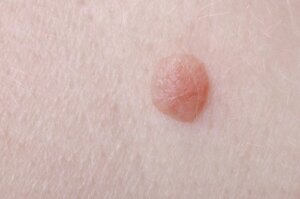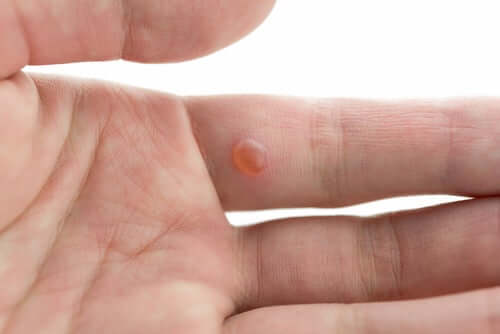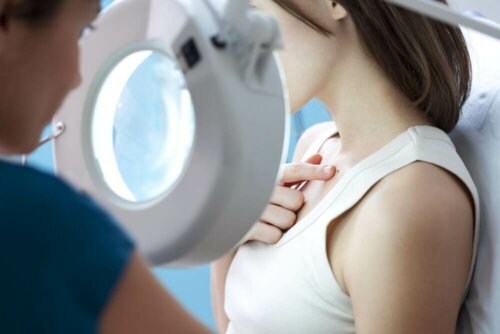Five Treatments to Get Rid of Flat Warts


Reviewed and approved by the doctor Karla Henríquez
Flat warts are small lesions in the skin. They’re slightly elevated and reddish-brown colored and are characterized by having a flat surface. They frequently appear on some parts of the face, but they also tend to be found on the hands and neck.
Flat warts are another common manifestation of the human papillomavirus (HPV) that often affects the adolescent population. They don’t represent a serious problem, but they’re contagious and come out about when your immune system is weakened.
What treatments are there to treat them? Are there ways to make them go away? We would like to answer these questions. In addition, we will review some of the most important facts about this dermatological problem. Get to know more about it!
Why flat warts appear
As we mentioned above, warts are a manifestation of the human papillomavirus (HPV) infection, of which there are more than 100 different subtypes. Specifically, flat warts are caused by HPV types 3, 10, 28, and 49.
Unlike the strains that cause genital HPV, these are benign and pose no risk beyond the appearance of the wart. However, it’s precisely their appearance that makes people want to remove them.
Read more: The Characteristics of Genital Pimples and Its Causes
How to recognize flat warts

Flat warts are slightly smaller than other types of warts. In addition, their head isn’t rough but smooth. They’re less raised, may have a round or oval shape, and usually range from 1 to 3 millimeters.
These warts often grow in clusters of 20 to 200 warts. They often occur around areas of skin that have been scratched or broken. Although they aren’t usually a problem, they can sometimes bleed and hurt.
Treatments to get rid of flat warts
Currently, there are a number of treatments for flat warts, you can even get rid of some of them. However, note that many of them disappear on their own without treatment. In any case, it’s best to see a dermatologist for a proper diagnosis if they’re present.
Your dermatologist can provide advice on a number of remedies, medications, and innovative therapies to fix this problem. In addition, they’ll help choose a less aggressive option to prevent scarring if you have flat warts on your face.
According to information published by Academia Española de Dermatología y Venereología, methods to treat this condition may include salicylic acid, cryotherapy, laser, electrocoagulation, among others. Let’s look at their characteristics.
1. Salicylic acid
Salicylic acid concentrations ranging from 10% to 20% have shown positive effects in the treatment of flat warts. In fact, it’s one of the first-line therapies for dealing with this cosmetic problem. However, it must be applied every day, for several weeks, for best results.
2. Cryotherapy

Cryotherapy uses liquid nitrogen to freeze the wart. It’s one of the therapeutic options that stand out for its speed, although its application involves some discomfort. To remove the entire wart may require a treatment for 2 to 4 times every 1 to 3 weeks.
Sometimes, it doesn’t give good results and forces the dermatologist to recommend other types of treatments. In addition, some patients experience pain and end up with scars.
Continue reading: Birthmarks and Moles: Why Do They Appear?
3. Cantharidin
Cantharidin is a chemical compound obtained from the Spanish fly (Lytta vesicatoria). Applied topically, it has the ability to generate blisters without causing residual scarring. Because of this action, people often use it to make warts disappear.
In most cases, the person doesn’t experience any pain when the product is applied. Once applied, the doctor will remove it within 3 to 8 hours and they’ll cover the wart with a bandage. Then, they’ll remove it after 24 hours. The treatment has a 70 percent response rate after 2 applications.
4. Electrocoagulation
This procedure is more aggressive than the previous ones. In fact, it requires the use of anesthesia and requires post-op care. Although it can be effective in removing the wart, it can leave scars.
5. Pulsed dye laser
This treatment stands out because it’s faster. However, it lacks evidence of efficacy, causes pain, and may leave scarring. In addition, it’s much more expensive than other options.
Do home remedies work?
Grandma’s popular remedies are options against warts for some. However, there’s no evidence to demonstrate their safety and efficacy to date. In fact, some may be aggressive and cause skin burns.
So, it’s important to find out if these cause side effects before using any of them. Ask your doctor if possible. Do you still have doubts? Consult your dermatologist and find out what are your treatment options.
All cited sources were thoroughly reviewed by our team to ensure their quality, reliability, currency, and validity. The bibliography of this article was considered reliable and of academic or scientific accuracy.
- Al Aboud AM, Nigam PK. Wart (Plantar, Verruca Vulgaris, Verrucae) [Updated 2019 Sep 27]. In: StatPearls [Internet]. Treasure Island (FL): StatPearls Publishing; 2019 Jan-.
- Maranda E, Lim V, Nguyen A, Nouri K. Laser and light therapy for facial warts: a systematic review. Journal of the European Academy of Dermatology and Venereology. 2016;30(10):1700-1707.
- Abeck D, Fölster-Holst R. Quadrivalent Human Papillomavirus Vaccination: A Promising Treatment for Recalcitrant Cutaneous Warts in Children. Acta Dermato Venereologica. 2015;95(8):1017-1019.
- InformedHealth.org. Cologne, Germany: Institute for Quality and Efficiency in Health Care (IQWiG); 2006-. What are the treatment options for warts?. 2014.
-
Revenga F, Paricio JF. Las verrugas. Medicina Integral. 2001: 37(9): 395-403.
- Balziskueta E, Encabo B, Gaminde M, Gracia L. Verrugas. Farmacia Profesional. 2002; 16(1): 42-51.
- Harris Ricardo J, Rebolledo Cobos M, Camacho Chaljub F, Carmona Lorduy M, et al. Ácido tricloroacético, una opción terapéutica en la hiperplasia epitelial focal: Presentación de un caso. Av Odontoestomatol. 2010; 26( 6 ): 323-326.
This text is provided for informational purposes only and does not replace consultation with a professional. If in doubt, consult your specialist.








